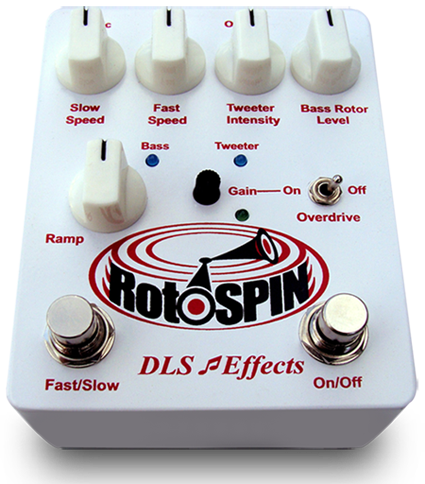
Effects designers have devised some pretty clever ways to approximate the sounds of a rotary speaker. A lot of these pedals, like the Uni-Vibe, became sonic categories all their own, with cults of nitpickers that debate the relative merits of different versions. But no matter how good a chorus, vibe, or phaser sounds—no matter how hip they can sound in just the right context—they’ll never quite nail the whirling, swirling, undulating properties of those original spinning, mechanically modulating leviathans.
Pedal designers, however, are nothing if not a stubborn bunch. And in the never-say-die quest to build a Leslie in a box, digital magicians have closed the gap. We’ve seen some great digital rotary simulators in recent years like the Strymon Lex and Neo Instruments Ventilator, but the compact and killer sounding DLS RotoSPIN is right up there with the best. It’s good enough to be downright indistinguishable from a Leslie in the right recording environment. And when used to the full extent of its capabilities, it sounds captivating and convincing on stage, too.
Power to Swirl There are days when anything more than a two-knob fuzz looks like a headache to me. And the day I opened up the DLS was one of them. But what you find out fast is that this set of controls is intuitive to the point of being dummy proof.
Two knobs on the upper left set the respective speeds of the slow and fast modes. The two just to the right of that control the intensity and level of the virtual rotating tweeter and bass rotor (or horn and drum, as they are better known in some quarters). As we’ll see, these controls are very interactive and much more (and often more subtle) than simple volume controls.
The lower left ramp knob controls the rate at which the virtual rotor rotations come to full speed when you switch between slow and fast speeds. Just to the right of that, there’s a gain knob and a switch that engages the drive channel. Two footswitches are for bypass and the fast/slow modes.
You could work with these controls exclusively and get plenty of great sounds out of the DLS. But there are a lot under-the-hood tweaks you can make to fine-tune the pedal for your rig. Some of the most effective controls relate to the stereo outputs, which have their own unique sonic qualities. Output A is voiced to be fatter. Output B is brighter. But they also have their own internal volume control pots, which can change the voice and the way the pedal interacts with the amp you put at the other end. Yet another internal pot enables you to increase the intensity of pitch bend (or Doppler effect, as they call it) on the tweeter. Here, again, this control can significantly re-shape the personality of the pedal.
In general, the RotoSPIN seems exceptionally well built. The very busy circuit board is well ordered. And to the extent that much of the circuit must be a carryover from the larger DLS RotoSIM, it’s surprising that it’s as tidy as it is and has room for the input gain control, two volume controls, and the pitch intensity pot.
Ratings
Pros: Very convincing and rich rotary simulations. Intuitive and streamlined when you need it to be. Tweakable when you need to fine tune. Versatile stereo functionality.
Cons: Treblier tweeter settings can betray small traces of digital voice. No expression pedal option.
Tones:

Ease of Use:

Build/Design:

Value:

Street: $259
DLS Effects RotoSPIN dlseffects.com
Swirl On Sister! One the beautiful things about the RotoSPIN is how satisfying it is before you ever tweak or fine-tune any of the controls. The manual explains that setting all four knobs to noon effectively replicates an old Fender Vibratone. And sure enough, in the fast setting the DLS delivers the same sassy, satisfying warble of Mike Campbell’s “You Don’t Know How it Feels” textures and SRV’s queasier riffs. Interestingly, this is one setting that you can approximate pretty well with a good analog chorus on a heavy depth setting. And yet, the differences between the two effects are profound. The DLS is much more rich and complex than a chorus. The shades between virtual spin cycles are more vivid. There’s also a certain toughness and attitude to the modulations—especially with a little drive.
The prescribed Leslie 122 setting is delicious and a highlight of how rich the DLS sounds compared to a chorus, phaser, or vibrato. In stereo mode this setting is heavy, gently pulsing, and dreamy—and sounds especially fat in Drop D and other slack tunings.
When you stray from the prescribed formulas for Vibratone or Leslie 122/145 cabs, you start to hear how subtle and interactive the tweeter and bass rotor controls are. DLS claims they simulate properties and parameters like “width” and microphone proximity rather than just volume, and they are understated rather than transformative. Given how nice and realistic the basic rotary voice is, that’s no bad thing. At times the tweeter and bass rotor knobs feel quite like controls on an old Fender amp, which will almost exponentially emphasize bass by reducing treble.
You can further tweak the character of the treble sounds, however, by adding pitch shift depth with the internal pot. And one of my favorite settings used a heavily pitch shifted but low-level tweeter setting with a more present and slightly louder large-to-mid-size cabinet setting on the bass side. This setting sounded even cooler in stereo. In fact, just about every setting sounded deeper and richer with two amps, which opens up cool possibilities related to other effects. I became addicted to the very intoxicating sound of running one of the stereo channels with a slapback delay on multiple repeats, for instance.
The Verdict Good Leslie simulators tend toward the expensive side of the spectrum. So the $259 street price that DLS asks for the very smart, convenient, streamlined, and easy-to-use RotoSPIN is a relative value—even if some competitors may have more features or sound ever so slightly more authentic in isolated situations. It’s likely to hold its own and then some against the competition in the studio. And live and loud through two amps, this rotary simulator is hard to top at any price.
